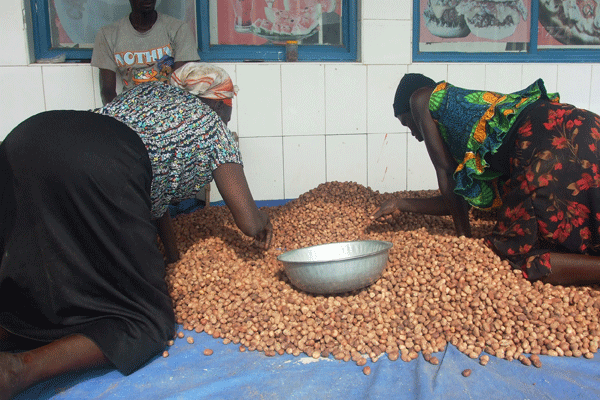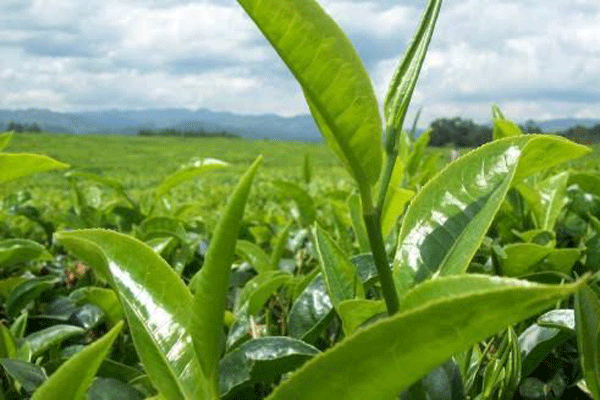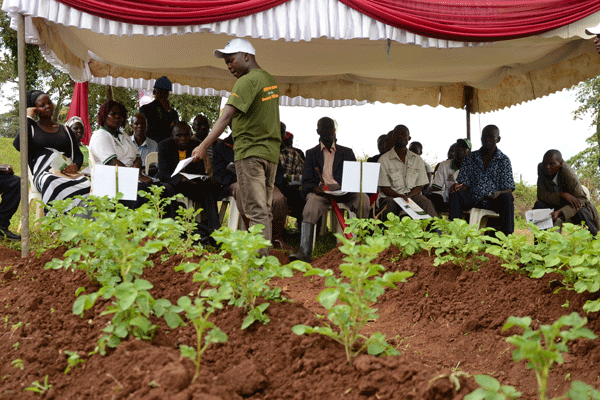Prime
Tips for starting shea agribusiness

Farmers sort shea nuts after harvesting. They sell the nuts to factories based in northern Uganda. PHOTO/FILE
What you need to know:
- The roasted shea nuts are ground into a smoother paste; water is gradually added and the paste is mixed well by hand.
Shea butter is a fat extracted from the nut of the African shea tree (Vitellaria paradoxa).
In Uganda shea butter or moo yao as it is known in Lango and Acholi sub-regions, awa-du among the Madi and kumura odu in Lugbara is from an indigenous fruit tree that grows mostly in the northern part of the country.
Shea butter is a triglyceride (fat) derived mainly from stearic acid and oleic acid. It is widely used in cosmetics as a moisturiser, salve or lotion. Shea butter is edible and is used in food preparation. A shea nut tree needs an average of seven to eight years to produce the first harvest. However, when faced with adverse environmental factors such as bush fires, the shea nut tree may become stunted and take up to 15 years to bear fruit.
During harvest, a shea nut tree can yield up to 20 kilogrammes of fresh fruit which produces about five kilogrammes of dry kernel that are made up of 42 to 48 percent oil. The fruits resemble plums and take about four to six months to fully ripen.
Breeding
Since 2011, the National Agricultural Research Organisation (Naro) in collaboration with the World Agroforestry Centre (ICRAF) has been managing a small amount of shea tree gene bank at the National Agricultural Forestry Resources Research Institute (NaFORRI).
This is the first gene bank in the country specifically holding shea tree accessions from the entire range of the species in Uganda. The gene bank has not only been used to study nursery tree generation but has also been utilised as a research platform. Dr Francis Esegu Osoto a geneticist majoring in tree breeding says the shea tree species is an important tree for rural farmers in the country because it is a source of food, medicine as well as income especially for women who sell the butter and oil on local market.
How to plant
The shea nut tree typically grows wildly though more farmers in Uganda have begun growing it domestically. When it matures, it bears fruit once a year.
Clear an area of well-drained soils preferably sandy or clay. It is best that you sow the seeds towards the end of the rainy season to ensure proper drainage.
The seeds should be half buried with the eyes facing upward.
The spacing between the seeds placed in the soil should be between two to three metres. Apply organic fertiliser to the soil. We recommend that you use organic fertilisers because inorganic fertilisers destroy soil quality.
Water your seeds in the early stages to ease absorption of nutrients from the soil and to protect the soil from other dry conditions. Remove weeds around the seedlings regularly to avoid competition. The seed propagation has been perfected at NaFORRI with a possibility of 70 percent success rates. Different shea tree types are being tested for their genetic viability and possibility of developing them with reduced rotation fruiting age of four to five years.
Weeding
Farmers are expected to clear an area of well-drained soils preferably sandy or clay and plant the raised seedlings during rainy season. They can also plant seed directly which must be half buried with the eyes facing upward.
For those who can afford, organic fertiliser can be applied to the soil and water the seeds in the early stages to ease absorption of nutrients from the soil and to protect the soil from other dry conditions. Scientists from Abi Zonal Agricultural Research and Development Institute (AbiZARDI) are involved in carrying research on as to how to improve ways of breeding of the plant.
“We are trying to develop massive propagation methods by raising seedlings,” says Dr Dan Acema the lead researcher.
Harvesting and processing
The traditional method of harvesting shea nut is to allow the seed to fall off the ground by themselves.
However some farmers use sticks to pluck the seed from the tree. Usually communities harvest the seed from trees that grow within their vicinity since the tree is owned communally. Thereafter se-pulping is done to get rid of the sweet fleshy fruit by boiling the fruit. They are then left to ferment.
The fermented fruits are then sun-dried for about 10 days at temperatures below 50 degree Celsius for seed isolation.
Cracking
Farmers are expected to remove the outer pulp when seeds have dried to get the nut, which is the source of shea butter.
Crushing
To make the shea nuts into butter, they must be crushed. Traditionally, this is done with mortars and pestles. It requires pounding the nuts to crush them so they can be roasted.
Roasting and grinding
The crushed nuts are roasted in pots over open wood fires. The pots must be stirred constantly with wooden paddles so the butter does not burn and later the roasted shea nuts are ground into a smoother paste; water is gradually added and the paste is mixed well by hand.
Separating the oils
The paste is pressed by hand in large basins and water is gradually added to help separate out the butter oils.
As they float, the butter oils, which are in a curd state are removed and excess water squeezed out. The butter oil curds are then melted in large open pots over slow fires. Slow boiling will evaporate any remaining water.
Collecting and shaping
The shea butter which is creamy or golden yellow at this point is collected from the top of the pots and put in cool places to harden. Industrially, a mechanical sheller such as the universal nut sheller may be used. The refined butter may be extracted with chemicals such as hexane or by clay filtering.
Value addition
Shea butter has many uses. Throughout African communities, it is used extensively for food and is a major source of dietary as well as for medicinal use.
History
The history of shea as a precious commodity can be traced back to ancient Egypt, where shea butter was and continues to be used to protect the hair and skin in the fierce sun and the hot dry winds of African deserts and Savannah.




